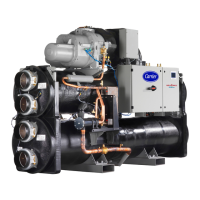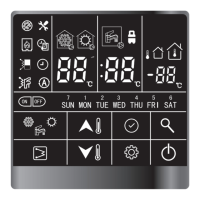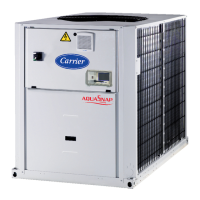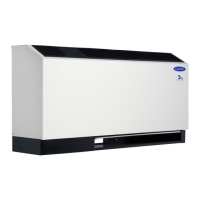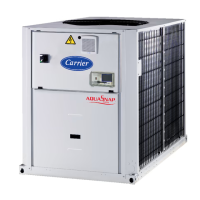6 - APPLICATION DATA
6.1 - Operating limits
30XW-V/30XWHV Minimum Maximum
Evaporator
Entering temperature at start-up - 35,0°C
Leaving temperature during operation 3,3°C 20,0°C
Entering/leaving temperature difference at full
load
2,8 K 11,1 K
Condenser
Entering temperature at start-up 13,0°C
(1)
-
Leaving temperature during operation 19,0°C
(1)
50,0°C
Entering/leaving temperature difference at full
load
2,8 K 11,1 K
(1) For lower condenser temperatures a water ow control valve must be used
at the condenser (two or three-way valve). Please refer to option 152 to ensure
the correct condensing temperature.
Note: Ambient temperatures: These units are dedicated for indoor environment. The
external temperature at chiller start up should be at least 5°C. For such low
ambient, option 152 is recommended. During storage and transport of the
30XW-V/30XWHV units (including by container) the minimum and maximum
permissible temperatures are -20°C and 72°C (and 65°C for option 200).
Evaporator leaving water temperature, °C
Condenser leaving water temperature, °C
15
20
25
30
35
40
45
50
55
From approx. 50% to full load
Part load limit approx. 50%
Minimum load limit
For more precise details please refer to the unit selection program.
6.2 - Condenser-side installation
recommendation
To ensure unit start-up at low condenser water temperature
conditions, a specic installation may be necessary. Please refer
to the table below:
0 < t < 20 min 20 < t < 40 min 40 < t < 60 min t > 60 min
15°C < x
13 < x <
15°C
11 < x <
13°C
8 < x < 11°C
x < 8°C
x Condenser water temperature before start-up
t Time required to reach a temperature of 19°C at the condenser outlet
1 The unit can start without the use of a two- or three-way valve,
but operation will be more reliable with the control valve.
2 The use of a two- or three-way valve is strongly recommended.
3 The use of a two- or three-way valve is compulsory.
4 The use of a two- or three-way valve is compulsory and the
use of variable-speed pumps is strongly recommended.
6.3 - Minimum chilled water ow
The minimum chilled water ow is shown in the table in chapter
6.7 “Evaporator and condenser water ow rates”.
If the system ow is less than the minimum unit ow rate, the
evaporator ow can be recirculated, as shown in the diagram.
For minimum chilled water ow rate
1
2
Legend
1. Evaporator
2. Recirculation
6.4 - Maximum chilled water ow
The maximum chilled water ow is limited by the permitted pressure
drop in the evaporator. It is provided in the table in chapter 6.7
“Evaporator and condenser water ow rates”.
• Select the option with one water pass less that will allow a
higher maximum water ow rate (see option 100C in the
table in chapter 6.6 “Number of passes”.
• Bypass the evaporator as shown in the diagram to obtain
a lower evaporator ow rate.
For maximum chilled water ow rate
2
2
1
Legend
1. Evaporator
2. Bypass
6.5 - Condenser water ow rate
The minimum and maximum condenser water ow rates are shown
in the table in chapter 6.7 “Evaporator and condenser water ow
rates”.
If the system ow is higher than the maximum unit ow rate, select
the option with one pass less that will allow a higher maximum
water ow rate. Please refer to option 102C in the table in chapter
6.6 “Number of passes”.
17
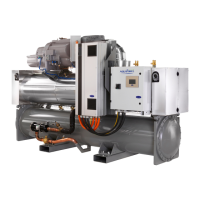
